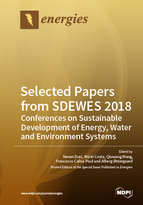Selected Papers from SDEWES 2018 Conferences on Sustainable Development of Energy, Water and Environment Systems
A special issue of Energies (ISSN 1996-1073).
Deadline for manuscript submissions: closed (31 December 2018) | Viewed by 128012
Special Issue Editors
Interests: energy planning of energy systems with a high penetration of renewables; sustainable communities; energy policy; energy economics; mitigation of climate change; energy efficiency and combustion engineering
Special Issues, Collections and Topics in MDPI journals
Interests: conventional and alternative fuels; particulate and aerosol formation and abatement; heterogeneous processes; advances in diagnostic methods in combustion; gas turbines; small- and large-scale stationary combustion and power generation; new concepts
Special Issues, Collections and Topics in MDPI journals
Interests: heat transfer enhancement and its applications to engineering problems; high-temperature heat transfer and fluid flow; transport phenomena in porous media; numerical simulation, prediction, and optimization
Special Issues, Collections and Topics in MDPI journals
Interests: fuel cells; advanced optimization techniques; solar thermal systems; concentrating photovoltaic/thermal photovoltaic systems; energy saving in buildings; solar heating and cooling; organic Rankine cycles; geothermal energy; dynamic simulations of energy systems; renewable polygeneration systems
Special Issues, Collections and Topics in MDPI journals
Interests: energy systems; energy scenarios; renewable energy system integration; energy and development; environmental impacts from energy development
Special Issues, Collections and Topics in MDPI journals
Special Issue Information
Dear Colleagues,
One of the main issues of the coming decades is the need to improve efficiencies by integrating various life supporting systems, using waste from one as a resource in another, in the exact moment when it is beneficial to all, integrating electricity, heating, cooling, transport, water, buildings, waste, wastewater, industry, forestry, and agriculture systems. Sustainability is also a perfect field for the interdisciplinary and multi-cultural evaluation of complex systems. The SDEWES conferences have become a significant venue for researchers in those areas to meet and originate, discuss, share, and disseminate new ideas.
Energy has been and is the key-factor in human development. However, it is also one of the main—if not the main—human environmental fingerprints. Even with the significant attention paid to the importance and merits of sustainable energy supply over the past several decades, there are still significant gaps to be filled with respect to how to design and implement technically optimal energy systems at the lowest costs.
This Special Issue aims to provide an important contribution by presenting state-of-the-art knowledge with sustainable energy supply solutions ranging from the technical analyses of energy components on both supply and demand sides to energy scenarios and pathways. This Special Issue particularly welcomes SDEWES papers that address the energy system without traditional sector boundaries between electricity, heating, cooling, transportation, and industrial demands, and rather considers the integration and synergies between these sectors.
Three conferences on the Sustainable Development of Energy, Water and Environment Systems (SDEWES Conferences) were held in 2018: the 1st Latin American SDEWES in Rio de Janeiro, Brazil in January, the 3rd Southeast European SDEWES in Novi Sad, Serbia in July, and the 13th SDEWES in Palermo, Italy in October, were dedicated to the improvement and dissemination of knowledge on methods, policies, and technologies for increasing the sustainability of development by de-coupling growth from natural resources and replacing them with knowledge-based economy, taking into account economic, environmental, and social pillars.
Prof. Dr. Neven Duić
Prof. Dr. Mário Costa
Prof. Dr. Qiuwang Wang
Prof. Dr. Francesco Calise
Prof. Dr. Poul Alberg Østergaard
Guest Editors
Manuscript Submission Information
Manuscripts should be submitted online at www.mdpi.com by registering and logging in to this website. Once you are registered, click here to go to the submission form. Manuscripts can be submitted until the deadline. All submissions that pass pre-check are peer-reviewed. Accepted papers will be published continuously in the journal (as soon as accepted) and will be listed together on the special issue website. Research articles, review articles as well as short communications are invited. For planned papers, a title and short abstract (about 100 words) can be sent to the Editorial Office for announcement on this website.
Submitted manuscripts should not have been published previously, nor be under consideration for publication elsewhere (except conference proceedings papers). All manuscripts are thoroughly refereed through a single-blind peer-review process. A guide for authors and other relevant information for submission of manuscripts is available on the Instructions for Authors page. Energies is an international peer-reviewed open access semimonthly journal published by MDPI.
Please visit the Instructions for Authors page before submitting a manuscript. The Article Processing Charge (APC) for publication in this open access journal is 2600 CHF (Swiss Francs). Submitted papers should be well formatted and use good English. Authors may use MDPI's English editing service prior to publication or during author revisions.
Keywords
- sustainability comparisons and measurements
- smart energy systems
- energy policy
- water–energy nexus
- energy system analysis
- renewable energy resources
- primary energy resources
- renewable electricity generation systems
- thermal power plants
- district heating and/or cooling
- advanced sustainable energy conversion systems
- renewable heat systems
- biofuels and biorefineries
- alternative fuels
- hybrid and electric vehicles
- water treatment for drinking water
- modelling for pollution avoidance and energy efficiency
- cogeneration, trigeneration, polygeneration
- energy storage
- electricity transmission and distribution
- gas security of supply
- energy efficiency in industry and mining
- energy-efficient appliances
- energy efficiency in buildings
- energy markets
Related Special Issues
- Selected Papers from SDEWES 2017: The 12th Conference on Sustainable Development of Energy, Water and Environment Systems in Energies (18 articles)
- Selected Papers from the SDEWES 2022 Conference on Sustainable Development of Energy, Water, and Environment Systems in Energies (14 articles)
- Selected Papers from the SDEWES 2021 Conference on Sustainable Development of Energy, Water and Environment Systems in Energies (14 articles)
- Selected Papers from the SDEWES 2020 Conference on Sustainable Development of Energy, Water, and Environment Systems in Energies (15 articles)
- Selected Papers from SDEWES 2019 conferences on Sustainable Development of Energy, Water and Environment Systems in Energies (14 articles)










